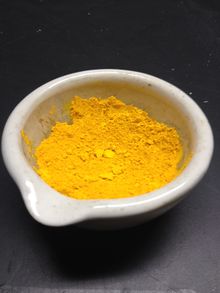Lead(II) chromate
 |
This article is a stub. Please help Sciencemadness Wiki by expanding it, adding pictures, and improving existing text.
|
Lead(II) chromate is an inorganic chemical compound with the chemical formula PbCrO4. It has historically been used as a yellow pigment in paints, often under the name Chrome Yellow.
Contents
Properties
Chemical
Lead chromate, like other chromates, contains chromium in the +6 oxidation state, often referred to as hexavalent chromium, which is highly oxidative. As a result, lead chromate may react with certain reducing agents or organic compounds. It may also be decomposed by strong acids.
Lead chromate can also be converted to another pigment, chrome orange, by preparing a hot slurry of it in water and adding solid sodium hydroxide while stirring. The hot sodium hydroxide solution partially leaches the lead chromate, producing a single crystal structure containing both lead chromate and lead(II) oxide.
Physical
Lead(II) chromate appears as a fine, wettable yellow to yellow-orange powder in pure form. The intense color of lead chromate when properly prepared has led it to be used as a pigment, though this has since been largely phased out due to its toxicity.
Availability
Lead chromate can be found as the pigment chrome yellow, but this may not be available in many locations due to the toxicity of lead.
Preparation
Lead chromate can easily be synthesized with a high yield by combining a solution of lead(II) nitrate or lead(II) acetate with another solution of a water soluble chromate or dichromate, such as potassium dichromate.
Projects
- Homemade yellow paint
Handling
Safety
Lead(II) chromate contains lead and hexavalent chromium, which are both toxic, and may oxidize certain organic compounds. As such, it should never be handled with bare hands and care should be taken that no lead chromate dust is inhaled when using it.
Storage
Lead chromate is stable in all storage conditions, but care should be taken that it is not handled by those unaware of the dangers it presents.
Disposal
Lead chromate should be reduced if possible to convert hexavalent chromium to the less hazardous chromium(III) ion before disposal. Because of its insolubility, it is unlikely that lead chromate would pose a significant leaching hazard in landfills if it is merely disposed of in the trash. Lead is a persistent environmental toxin, however, so it should never be disposed of directly into nature.
